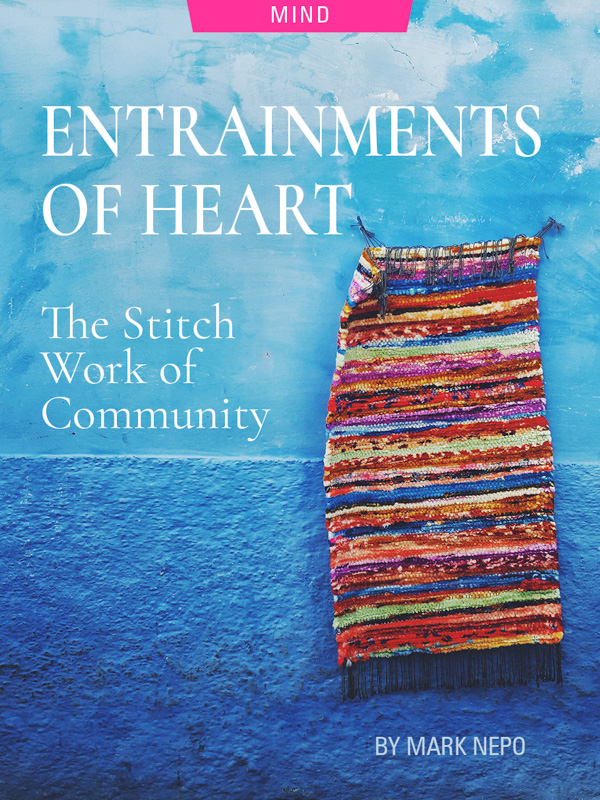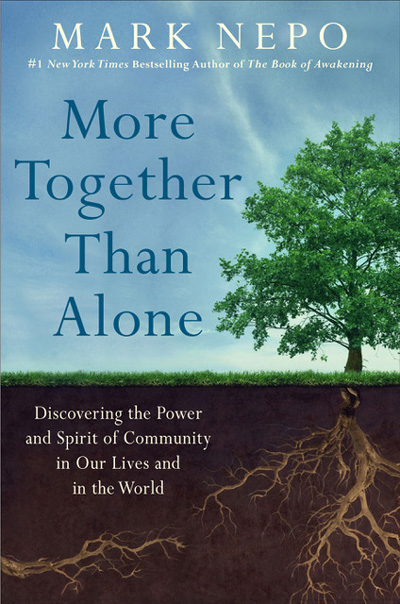An exploration of community and the connections that nurtures our souls across beliefs, cultures, borders and religions.
—
There is one soul and many tongues, one spirit and various sounds; every country has its own speech, but the subjects of speech are common to all.
Tertullian, c. 217
In creating any kind of community, it’s important to recognize that we at heart are the same and connected under all our differences. This fundamental view of life as interconnected and interdependent affects how we educate and govern. In every age, seeking truth and meeting trouble bring us together and make our underlying connections visible. In 1838, James Fenimore Cooper argued that a free community is based on “the necessity of speaking truth, when speaking at all; [and] a contempt for all designing evasions of our real opinions.”
Yet there’s a difference between telling the truth and experiencing the truth.
When we open our heart to concerns beyond our own, we start to experience the truth we’re all a part of.This opening to concerns other than our own is the stitch work of community. I saw this quote from Martin Luther King, Jr. painted on a newspaper vending machine:
“An individual has not started living until [they] can rise above the narrow confines of [their] individualistic concerns to the broader concerns of all humanity.”
Under all the ways we can study and learn, it’s an open, truthful heart that lets us live in rhythm with others. This impulse to share the journey is a fundamental force of nature. In physics, rhythm entrainment is a phenomenon where if two objects vibrate in a similar way long enough, they entrain each other to a third, common amplified wave, which, in turn, is louder, stronger, deeper, and more far-reaching than their singular rhythms. Strange as it seems, this is how TV remotes work.
In a social sense, the vibration of the heart makes the fabric of community visible, through its capacity to entrain with the rhythms of others.
Tending to the life around us can invoke an entrainment of hearts. Such ways of tending to life include caring, truth-telling, listening, entering silence, being vulnerable, and telling stories. Embodying these aspects of being invoke the common rhythm between living things, which we then feel as a bond of relationship — louder, stronger, deeper, and more far-reaching than our singular feelings.
The Maori, the indigenous people of New Zealand, have a custom of sharing their breath. They touch noses and take in each other’s breathing and, in this nonverbal way, affirm that their lives are connected. They do this every time they meet and leave each other. In sharing their breath, the Maori entrain their hearts and find their common rhythm.
Our heartfelt attention to life as a whole yields a knowing that gathers throughout time, which can be understood as Collective Wisdom. Jung termed this storehouse of knowing across generations as the Collective Unconscious.
This web of knowing across all time may be the largest community of all, a community of souls.
The latest thinking in neurobiology affirms our common web of knowing. This micro-science is exploring the kinetic energy that exists between cells and how the information passed there enables each cell to do its part in a concerted way that none could do alone. It’s compelling to view the energy fields that exist between cells as a collective neuro-conversation that enables life to happen at its most elemental level. In this way, the common rhythms of neurology can be seen as a biological form of collective wisdom. In essence, each person is a dynamic biological community.
In our everyday encounters, we stumble into the question:
How do we understand and access the magic of what we know together which no one can know alone?
Because of the subtlety of this knowledge across time, every tradition has its mystical way of inquiring about our place in the community of life. Many traditions offer mystical schools of inquiry devoted to embodying our direct connection with life as a whole.
Within the Jewish tradition, listening for the indwelling presence of God helps us know the truth of life. The story of Rabbi Zusya of Hanipol speaks to this. The rabbi taught in the 1700s in the town of Tarnow in southeastern Poland. A Hasidic leader, he spent long hours studying the Talmud. One day, he left his students to read a certain passage. A day later, his students found him still dwelling on the first page. They assumed he had encountered a difficult notion and was trying to solve it. But when a number of days passed and he was still immersed in the first page, they were troubled. Finally, one of them gathered courage and asked the master why he didn’t move to the next page. And Rabbi Zusya answered: “I feel so good here, why should I go elsewhere?”
This story points to the reason for all learning. Under all our struggles, what we learn as a human family is that all paths and choices are vehicles for love to do its work wherever we are.
When we can devote ourselves to what we find in each other, we welcome life wherever it may show itself.
In a stranger or a bird or an old familiar lighthouse. Or in the animated conversations that flit from park bench to park bench in the city where we live. Each moment, if entered, can connect us to the whole of life.
Within the Buddhist tradition, Vajrayana holds the spiritual aim of embodying ultimate truth with the vow to help others in their path to liberation. Vedanta, which literally means “the end of knowledge,” is a mystical path within the Hindu tradition that seeks to uncover the relationship between the unknown and unseeable aspects of life and the knowable and seeable aspects of existence.
Within the Islamic tradition, Sufism aims to release the experience of joy that comes from overcoming our lesser self, while trying to experience the Divine in everything. Mystics within the Sikh tradition believe that the Oneness of God is manifest in the practical life of truthfulness and service.
Within the tradition of Jainism, Moksha is a mystical path that works toward our unification with all life, in the belief that this unification will liberate us from our rebirth into the cycle of suffering.
Within Judaism, the Kabbalah is a course of study meant to surface the relationship between the unchanging, eternal mystery of life and the finite experience of human beings.
At the same time, Christian mysticism explores experiences of the soul that have no physical or earthly cause, trying to know and honor the unseeable Divinity that holds everything together.
And the mystical qualities of Taoism hold that we are born to live in accord with the larger, intangible current of life, the way a fish finds and swims with the current of the sea.
Each of these traditions offers an entrainment of heart by which we can experience the common rhythm of life, as it beats now and throughout the community across time we call Eternity.
These are not abstract paths. Some people use the mystical path as a way to retreat from living in the world, but the true value of entraining our heart to the rhythms of life is that it enables us to live more fully in the world, with greater resolve and compassion.
Regardless of where you’re drawn to look, the practice of staying connected to life reveals the larger frame of all that joins us. If we can’t stay open to all that is larger than us, we will live from a self-centered frame of reference that will narrow our range of experience. The larger our frame of reference, the richer our understanding of how we can live together.
Imagine you’re driving alone along a road. If you limit your view of life to the one road you’re on, everything that comes along can seem an intrusion. But if you view life as a network of infinite roads, of which your road is one, the influx of other life seems inevitable, even desired.
When we can view the road we’re on as one path within a geography of paths, then the rich, all-encompassing community of life seems ever-present and healing.
Our path then includes the migration of antelope, flamingoes, and salmon, and the currents that clouds follow as they blanket the globe, as well as the migration of stories between generations, and the evolution of insight passed among the wisdom traditions throughout the centuries.
Being part of such a diverse geography of possibility informs our choices, even if we never stray from our personal road.
The larger our perspective, the more rhythms of life we encounter. The more rhythms of life we encounter, the deeper and broader our experience.
The deeper our experience, the more fellow travelers we admit. And the more fellow travelers we admit, the deeper our compassion and strength of heart. This is how community grows.
The abalone farmers in the East China Sea were compelled by the vast forces of life to find their common rhythms and work together. In generations past, lone fishermen would bob and drag their nets for abalone in the open sea, drifting near each other, but keeping their distance. Until a typhoon made it impossible to survive alone. And so, the lone fishermen tied up together in order to outlast the swell and pound of the storm. Once the storm passed, they discovered it was easier and more efficient to fish together.
Today, floating villages exist in the China Sea with platforms tied together for miles, to protect each other from typhoons and to share resources and tools. A similar interdependence is found in the floating fishing villages that string across Tonle Sap, a lake in Cambodia that swells to more than five times its normal size in the rainy season when the Mekong River floods the nearby forests and plains.
These are not just instances of survival, but times when life shows us that, if we can follow the common rhythms that bind us, we can come alive in the web of connections that holds the world together.
So, when the waves you can’t see get choppy and hard to withstand — in love, in suffering, in our search for life’s meaning — tie up with whoever is near, so you can withstand the storm together. And once you’re comfortable with the bonds between you, let others tie up when necessary. It will only make you stronger. Whether we realize it or not, or like it or not, we’re all part of a floating village, trying to bring up enough from the deep to make it to tomorrow.
—
The web of knowing across all time may be the largest community of all, a community of souls.
—
Footnotes:
“There is one soul and many tongues…” Tertullian, from the chart, “Reform Movements,” in Lapham’s Quarterly: Means of Communication, Volume V, Number 2: Spring 2012, p. 70.
“The necessity of speaking truth…” James Fenimore Cooper, in Lapham’s Quarterly, Volume V, Number 4: Politics, Fall 2012, p. 19.
“Rabbi Zusya of Hanipol…” From The Earth is the Lord’s: The Inner World of the Jew in Eastern Europe, Abraham Joshua Heschel. Woodstock, VT: Jewish Lights Publishing, 2001, p. 50.
You may also enjoy reading Community Co-Listening: Can We Listen Without Judgment? by Indira Abby Heijnen

